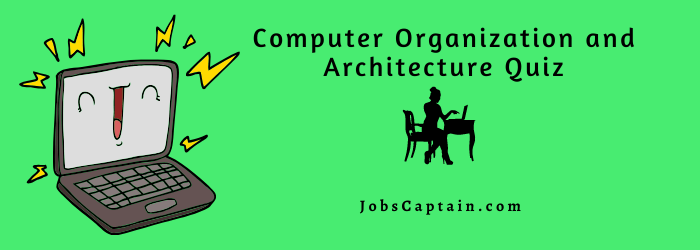
Computer Organization and Architecture Multiple Choice Questions and Answers pdf. It contains well thought and well-explained computer science and programming objective quizzes.
Computer Organization & Architecture Quiz with Answers
Let’s start Computer Organization and Architecture Quiz.
Question 1: How many digits are used in Binary number system?
(A) zero
(B) one
(C) two
(D) three
Question 2: What type of computer uses the binary number system?
(A) Analog
(B) Super
(C) Intra
(D) Digital
Question 3: What digit is called a bit?
(A) decimal
(B) binary
(C) octal
(D) hexadecimal
Question 4: Which component of the computer consists of physical entity of the device?
(A) software
(B) middleware
(C) hardware
(D) firmware
Question 5: Which consists of instructions and data that computer manipulates to perform data processing tasks?
(A) software
(B) middleware
(C) hardware
(D) firmware
Question 6: What is the term used for “sequence of instructions for the computer”?
(A) hardware
(B) program
(C) data
(D) instruction
Question 7: What is concerned with the way the hardware components operate to form computer system?
(A) Computer organization
(B) Computer design
(C) Computer architecture
(D) Computer implementation
Question 8: The manipulation of binary information is done by logic circuits called __________.
(A) blocks
(B) gates
(C) symbols
(D) functions
Question 9: Each gate can be represented in tabular form by __________.
(A) symbols
(B) function
(C) truth table
(D) logic
Question 10: If both inputs A and B are equal to 1 in AND gate, the output is ___________.
(A) zero
(B) one
(C) don’t care
(D) binary
Question 11: A Boolean function can be translated from ____________ expression into a logic diagram.
(A) boolean
(B) logical
(C) relational
(D) algebric
Question 12: The map simplification method is also known as ___________ map.
(A) karnaugh
(B) algebric
(C) basic
(D) binary
Question 13: The condition when it does not matter if the function produces 0 or 1 for a given minterm is?
(A) SOP
(B) POS
(C) NOR
(D) don’t care
Question 14: A _________ circuit is a connected arrangement of logic gates with a set of inputs and outputs.
(A) arithmetic
(B) logic
(C) combinational
(D) shift
Question 15: The addition of 2 binary digits is done by ___________ circuit.
(A) half adder
(B) full adder
(C) BCD adder
(D) composite adder
Question 16: A _________ is a combinational circuit that forms sum of 3 input bits.
(A) half adder
(B) full adder
(C) BCD adder
(D) composite adder
Question 17: The storage element employed in clocked sequential circuit is called ___________.
(A) memory
(B) flipflop
(C) circuit
(D) subtractor
Question 18: Minterm is also called ________.
(A) standard product
(B) standard sum
(C) union
(D) difference
Question 19: In flip-flop input R stands for __________.
(A) read
(B) reset
(C) reimburse
(D) rectangle
Question 20: In T flip-flop T stands for?
(A) technical
(B) toggle
(C) trigger
(D) type edged
Question 21: Special input terminal for setting the flip-flop is called _____________.
(A) clear
(B) set
(C) preset
(D) reset
Question 22: A _____________ circuit is an interconnection of flip-flops and gates.
(A) combinational
(B) arithmetic
(C) shift
(D) sequential
Question 23: The state table of sequential circuit consists of __________ sections.
(A) one
(B) two
(C) three
(D) four
Question 24: The ___________ state shows the states of flip-flops A and B at any given time t.
(A) input
(B) next
(C) present
(D) output
Question 25: Short form of “American Standard Code for Information Interchange”.
(A) ASCFII
(B) ASCII
(C) ASCFI
(D) ASCI
Question 26: The state of the flip flop after the occurrence of a clock pulse is called __________ state .
(A) high level
(B) present
(C) next
(D) low level
Question 27: Maxterm is also called ________.
(A) standard product
(B) standard sum
(C) union
(D) differnce
Question 28: The multiplexer is also called ________ selector since it selects one of many data inputs.
(A) line
(B) data
(C) binary
(D) octal
Question 29: A _______ is a digital circuit that performs the inverse operation of a decoder.
(A) multiplexer
(B) adder
(C) subtractor
(D) encoder
Question 30: A ________ is a group of flip-flops.
(A) memory
(B) circuit
(C) register
(D) bits
Go to Main Computer Quiz Topics
